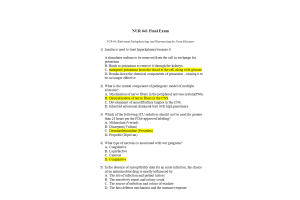BUSI 2003C-1, BUSI-2003-1; Week 6 Final Exam (100 out of 100 Points)Summer Quarter
Course : BUSI 2003 Operations
Contributed : Coleman
- $25.00
- Question: Throughput time, process flow rate, capacity, and average amount of inventory in the system are some of the key metrics of a manufacturing process.
- Question: A small value of a is used when we require a simple exponential smoothing model to be responsive to the recent demand pattern.
- Question: Five commonly employed forms of structural change of a supply chain include each of the following except:
- Question: Little's Law in a manufacturing process relates to:
- Question: Business Process Reengineering is an incremental approach to redesigning a business process.
- Question: Outsourcing occurs when a firm moves work performed internally to another facility belonging to the same firm but in another country.
- Question: Transportation of materials into or out of a facility is the responsibility of the logistics function.
- Question: A bank has an average of 10 customers per hour arriving into the system and it takes an average of 30 minutes for the clerk to complete a transaction with a customer. Determine the average length of the queue in the bank.
- Question: The forecasting techniques of exponential smoothing and moving average that have rapid response rates to changes in the mean level of demand have:
- Question: The hierarchy of decisions concerning the capacity of operations ranging from long-term to short-term in nature leads from:
- Question: Which of the following is not a step in the purchasing cycle?
- Question: Assume you have discovered from historical records that simple linear regression is an effective means of predicting the labor cost of some project tasks. You have found that the weight associated with an item (in pounds) produced in historical projects is an accurate and reliable predictor of labor cost. In fact, from these historical records, you have developed a linear equation expressing the relationship between the weight of the item and labor cost. The estimated regression equation is 1300 + 0.25 x. For an upcoming project, which includes the task of manufacturing an item weighing 7,000 pounds, what is your estimate of the task cost using this estimated regression equation?
- Question: A major assumption behind Little's Law is that the process is in steady state wherein the average output rate equals the average input rate to the process.
- Question: In a process thinking philosophy, it is important to:
- Question: If you were using a simple exponential smoothing forecast model (alpha value equal to 0.30), which generated a forecast of 25.10 units for the most recently completed week which has observed a demand of 31 units, what would be your forecast of demand for the upcoming week?
- Question: The process of constructing a flowchart for service operations is also referred to as service blueprinting.
- Question: Amazon.com is an example of B2B operations.
- Question: The four "costs of quality" include all of the following except:
- Question: A bottleneck is:
- Question: Which of the following matches between quality gurus and the guru's philosophy is incorrect?
- Question: A negative value of capacity cushion indicates that the average demand is less than the capacity available.
- Question: Utilization = Nominal Capacity/Output.
- Question: Specific measures of supply chain performance include all of the following except:
- Question: The concept of mistake-proofing was first developed in the 1960s by Shigeo Shingo. It was called:
- Question: Using a three-period, weighted moving average forecast model with weights of 0.50, 0.40, and 0.10 (weights decline with the age of the demand observation), what would the forecast of demand be for the upcoming week 6 given the historical demands shown below?

